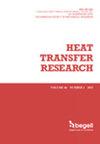评估带有光谱选择性吸收器的非聚光太阳能热电发生器中的热损失
IF 1.6
4区 工程技术
Q3 THERMODYNAMICS
引用次数: 0
摘要
太阳能热电发生器(STEG)已在光学和热聚光领域得到广泛研究,其光谱特性主要集中在太阳光谱上。然而,人们对没有任何聚光器的全光谱范围内的 STEG 的关注还很有限。因此,本研究根据热阻网络建立了 STEG 系统的热电耦合数学模型,以研究吸收器上方的热损失和发电性能。对于理想的选择性吸收器和发射器系统,吸收器的主要热损失是由于向天空的辐射冷却,对于理想的宽带吸收器系统也是如此,而不是对流和环境辐射损失。这些天空辐射冷却损失分别约占总热量损失的 83.8% 和 73.7%。与其他形式的热损失相比,水蒸气总量对辐射冷却功率的影响最大,而风速对对流热损失的影响最大。环境温度升高会导致各种形式的热损失减少。底面温度或太阳辐照度的增加会导致各种形式的热损失增加。考虑到 STEG 的成本效益和环保特性,本文就如何改进 STEG 的系统设计提出了建议,目的是最大限度地减少热损失,提高系统性能,并为其在各种应用中的广阔前景铺平道路。本文章由计算机程序翻译,如有差异,请以英文原文为准。
Evaluation of Heat losses in a non-concentrated solar thermoelectric generator with spectrally selective absorbers
Solar thermoelectric generator (STEG) has been widely studied in optical and thermal concentrating fields, and the spectral properties are mainly focused on the solar spectrum. However, limited attention has been paid to STEG without any concentrators and in the full spectral range. Therefore, in this work, a thermal-electrical coupled mathematical model for STEG systems is developed according to thermal resistance networks to investigate heat losses above the absorber and power generation performance. For the ideal selective absorber and emitter system, the main heat losses from the absorber occur due to radiative cooling to the sky as well as for the ideal broadband absorber system, as opposed to convection and ambient radiative losses. These sky radiative cooling losses account for approximately 83.8% and 73.7% of the total heat losses, respectively. The total water vapor has the greatest impact on radiative cooling power compared to other forms of heat loss, while wind speed has the largest effect on convective heat loss. Elevated ambient temperatures result in decreased heat loss across all forms. An increase in bottom surface temperature or solar irradiance results in an increase in various forms of heat loss. In light of its cost-effectiveness and environmentally-friendly characteristics, this paper offers recommendations on enhancing the system design of STEG aiming to minimize heat loss, enhance system performance, and pave the way for a promising future in various applications.
求助全文
通过发布文献求助,成功后即可免费获取论文全文。
去求助
来源期刊

Heat Transfer Research
工程技术-热力学
CiteScore
3.10
自引率
23.50%
发文量
102
审稿时长
13.2 months
期刊介绍:
Heat Transfer Research (ISSN1064-2285) presents archived theoretical, applied, and experimental papers selected globally. Selected papers from technical conference proceedings and academic laboratory reports are also published. Papers are selected and reviewed by a group of expert associate editors, guided by a distinguished advisory board, and represent the best of current work in the field. Heat Transfer Research is published under an exclusive license to Begell House, Inc., in full compliance with the International Copyright Convention. Subjects covered in Heat Transfer Research encompass the entire field of heat transfer and relevant areas of fluid dynamics, including conduction, convection and radiation, phase change phenomena including boiling and solidification, heat exchanger design and testing, heat transfer in nuclear reactors, mass transfer, geothermal heat recovery, multi-scale heat transfer, heat and mass transfer in alternative energy systems, and thermophysical properties of materials.
 求助内容:
求助内容: 应助结果提醒方式:
应助结果提醒方式:


